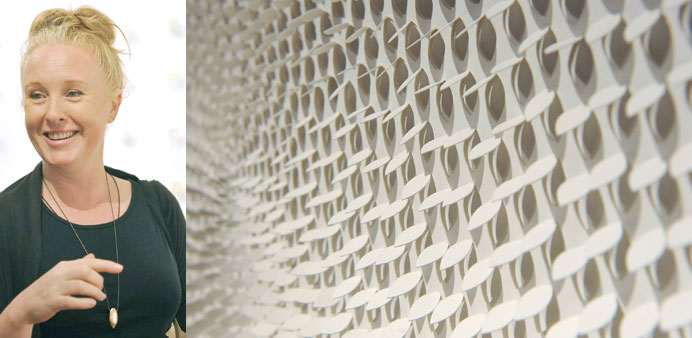NOT JUST PAPER: Artist Jaq Belcher’s work on display at the Papercuts exhibition in VCU-Q.
Jaq Belcher.
Artist Jaq Belcher’s paper-cutting work exhibited at VCU-Q uses the language of cuts, scale and
geometry to come out with interesting forms from single sheets of white paper. By Anand Holla
What has paper to do with exploring alternative states of consciousness? Artist Jaq Belcher’s captivating paper-cutting work that raises interesting forms from single sheets of white paper shows us just how it can be used to process such a complex subject.
Born in Australia and based in New York City, Belcher roots her art in “the process of reduction and repetition, manipulating the very essence of matter.” Belcher was down in Doha as two of her works were exhibited at Papercuts, the recently launched exhibition at Virginia Commonwealth University in Qatar, where artists have used various kinds of tools and paper to create works “that range from narrative commentaries to complex structural abstractions.”
For Belcher, the quest to explore the void, the space “between” is meditative and therapeutic. She tells Community, “Before I create it, I pretty much see it in my mind. I figure out the underlying geometry. It’s almost like a recipe. I know the scale I will use, I know the field I will cut, and then, it just happens. I have no idea what it’s going to look like in the end.”
Belcher believes “that art should not be thought of as an object but instead as an experience itself.” This philosophy draws on her references to eastern meditation, spiritual alchemy and sacred geometry.
Pointing at her work titled Spiral Nine which bears 2,144 cuts, she says, “I began in the centre and I just spiralled out. Every second time I passed through, I went up a level.” The cuts are of nine different sizes in this one. Another piece, bearing more than twice the number of cuts, interprets the interception of the ground energies and sky energies coming together.
In 2001, when Belcher moved to NYC, artist and the exhibition’s curator Reni Gower found her. “I didn’t want to work in media anymore. I wanted to work in a concentrated fashion. My interest was the manipulation of matter with, essentially, my mind. That practices the act of learning to concentrate.”
While in this space of stillness, Belcher began deconstructing the beauty of a single expanse of white paper. Wondering how one could add to such “a simple and beautiful void”, Belcher began doing the opposite, taking away from it by slicing out shapes. “So my enquiry was what would happen if I removed most of the matter from the sheet of the paper. I wouldn’t use any paint or pencils or anything else, and the original piece is just taking away the paper,” she says.
But then, it became too easy for her. “I could do it with my eyes closed. To up the level of concentration, this cut was born,” she says, pointing to a multiple cut, “Then to further up it, the four cut was born, where basically each raised form takes four cuts. It goes upto six cuts. There’s a language of cuts, scale and geometry, at play.”
The large number of cuts required to create each work is marked along the bottom and dated. “It’s kind of a commentary on what’s created that piece of work. And I leave all the pencil marks on the piece because I consider them drawings,” she says, “I have 28,500 cuts on some pieces. I just finished one with 16,417 cuts.” While initially, it used to take a long time to create a work, now she can finish a piece within a week if she wants to.
The exquisitely patterned works of Belcher are a testament to the idea of “being in the moment” and “staying in the now.”
In fact, as a note on her bio states, the patterns and shapes require not only herself but also the viewer “to maintain a type of meditation and focus on the work as it is experienced and worked through.” Belcher says, “I actually feel like I’m doing this because I am meant to be doing this. My practice comes from the evolution of consciousness.”

